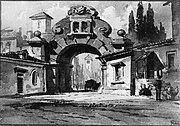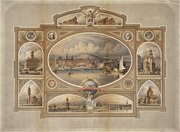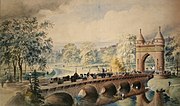|
Theodore Otto Langerfeldt
Theodore Otto Langerfeldt (March 2, 1841 – September 7, 1906) was a German-American architectural renderer, watercolorist, and painter. Biography Langerfeldt was born March 2, 1841, in Bückeburg, then capital of the German principality of Schaumburg-Lippe.[1] He studied architecture at Polytechnische Schule in Hanover. Circa 1863 Langerfeldt moved to England, where he studied and worked as a painter for five years. In 1868 he moved to the United States, settling in Boston, Massachusetts.[2] He was first noted in the Boston directories in 1870 as an architect with an office in the Studio Building. From 1875 until his death he is instead noted as a watercolor artist.[3] Langerfeldt was best known for his architectural subjects, and was often employed by architects of Boston and New York to prepare watercolor perspective renderings for competition entries or exhibitions.[4] These architects included Charles B. Atwood, George A. Clough,[5] George Keller,[6] McKim, Mead & White,[7] Peabody & Stearns,[8] William G. Preston[5] and Frederick W. Stickney.[5] Presenting a watercolor by Langerfeldt with a competition design was considered a great advantage.[4] In 1876, at the Centennial Exposition in Philadelphia, one of his drawings received an award.[2] He was one of the first artists to provide professional rendering services to architects, preceding a later generation which included E. Eldon Deane, David A. Gregg, and Hughson Hawley, among others. He largely withdrew from work for architects in the 1890s, as his health worsened.[4] Following an illness of ten years, Langerfeldt died September 7, 1906, in Boston.[1] Langerfeldt signed his drawings "T. O. L." In addition to his architectural work, Langerfeldt also painted landscapes, and had a solo show at the Boston Art Club in 1874.[2] Two of his landscapes are in the collection of the Museum of Fine Arts, Boston. Gallery of works
References
|
||||||||||||





